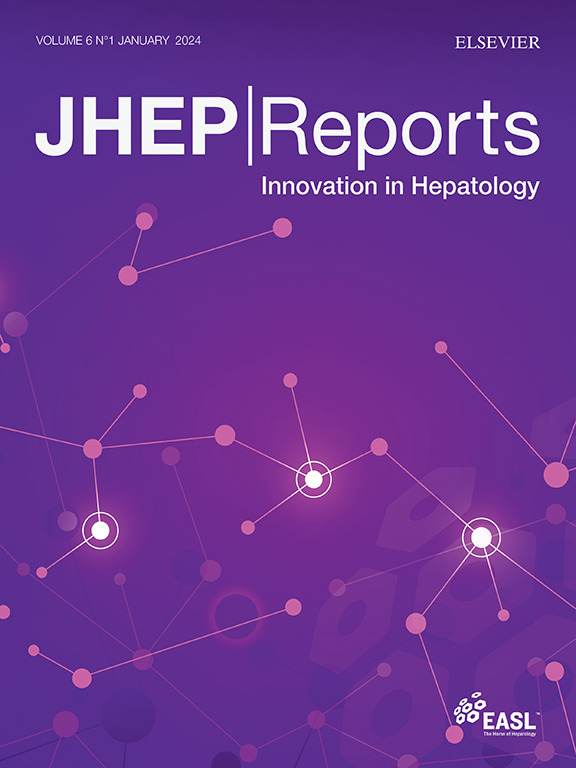DHCR7 inhibition ameliorates MetALD and HCC in mice and human 3D liver spheroids
IF 7.5
1区 医学
Q1 GASTROENTEROLOGY & HEPATOLOGY
引用次数: 0
Abstract
Background & Aims
Metabolic dysfunction and alcohol-associated liver disease (MetALD) results in the development of liver steatosis, inflammation, fibrosis, and hepatocellular carcinoma (HCC). De novo lipogenesis and cholesterol synthesis play an important role in the pathogenesis of MetALD. DHCR7 (7-dehydrocholesterol reductase) regulates the last stages of cholesterol production.
Methods
We investigated whether targeting DHCR7 can ameliorate the development of MetALD and HCC using experimental models and 3D human liver spheroids.
Results
Here, we demonstrate that partial genetic ablation of the Dhcr7 gene and pharmacological blockade of DHCR7 activity with the AY9944 inhibitor suppresses hepatic steatosis (↓ lipid area, n = 15; p <0.001), inflammation (↓ F4/80, n = 6; p <0.01), fibrosis (↓ Sirius red, n = 6; p <0.01), and HCC (↓ AFP/YAP, n = 6; p <0.01) in diethylnitrosamine (DEN)-challenged high-fat diet (HFD) + ethanol (EtOH)-fed mice treated with AY9944 compared with control mice. To translate our findings, the effect of DHCR7 was tested using 3D human liver spheroids, which mimicked MetALD and MetALD-HCC. MetALD liver spheroids were composed of primary human hepatocytes, non-parenchymal cells, and hepatic stellate cells. In contrast, in MetALD-HCC spheroids, the HCC cell line HepG2 was used instead of hepatocytes. Therapeutic administration of AY9944 inhibited inflammation (↓ TNF, p <0.05) and fibrosis in MetALD spheroids (↓ ACTA2, p <0.001; COL1A1, p <0.05; TIMP1, p <0.01; SERPINE1, p <0.05). In turn, dsiRNA-based knockdown of DHCR7 reduced HepG2 proliferation (↓ PCNA, p <0.05; CCNE, p <0.05) and expression of MetALD-HCC markers (↓ AFP, p <0.05; GPC3, p <0.05; YAP, p <0.01).
Conclusions
Our data demonstrate that targeting DHCR7 can become a strategy for the treatment of MetALD and HCC.
Impact and implications
This study demonstrates the critical role of de novo lipogenesis and cholesterol synthesis in the pathogenesis of metabolic dysfunction and alcohol-associated liver disease (MetALD) and its progression to hepatocellular carcinoma (HCC). Our findings identified that the upregulation of DHCR7 contributes to the pathogenesis of MetALD and its inhibition suppresses hepatic steatosis, inflammation, fibrosis, and tumor proliferation. These findings are significant for researchers and clinicians, as they establish that genetic and pharmacological inhibition of DHCR7 is effective in both experimental models and translational 3D human liver spheroids. The results uncover the translational potential of DHCR7-targeted therapies for MetALD and HCC, offering practical implications for the development of novel treatment strategies. Further studies are necessary to optimize these approaches and address potential methodological limitations.

抑制DHCR7可改善小鼠和人三维肝球体的MetALD和HCC
背景,目的代谢功能障碍和酒精相关性肝病(MetALD)导致肝脏脂肪变性、炎症、纤维化和肝细胞癌(HCC)的发展。从头脂肪生成和胆固醇合成在MetALD的发病机制中起重要作用。DHCR7(7-脱氢胆固醇还原酶)调节胆固醇生成的最后阶段。方法利用实验模型和三维人肝球体研究靶向DHCR7是否能改善MetALD和HCC的发展。结果本研究表明,部分基因消融Dhcr7基因和AY9944抑制剂对Dhcr7活性的药理学阻断可抑制肝脏脂肪变性(↓脂质区,n = 15;p <0.001),炎症(↓F4/80, n = 6;p <0.01)、纤维化(↓Sirius红,n = 6;p <0.01), HCC(↓AFP/YAP, n = 6;p <0.01),与对照组相比,AY9944对二乙基亚硝胺(DEN)激发的高脂肪饲料(HFD) +乙醇(EtOH)喂养小鼠的影响显著。为了解释我们的发现,我们使用模拟MetALD和metal - hcc的3D人肝球体来测试DHCR7的作用。金属肝球由人原代肝细胞、非实质细胞和肝星状细胞组成。相反,在MetALD-HCC球体中,使用HCC细胞系HepG2代替肝细胞。治疗给药AY9944抑制炎症(↓TNF, p <0.05)和MetALD球体纤维化(↓ACTA2, p <0.001;COL1A1, p <0.05;TIMP1, p <0.01;SERPINE1, p <0.05)。反过来,基于dsirna的DHCR7敲低可降低HepG2增殖(↓PCNA, p <0.05;CCNE, p <0.05)和metal - hcc标志物(↓AFP, p <0.05;GPC3, p <0.05;YAP, p <0.01)。结论sour数据表明,靶向DHCR7可成为治疗MetALD和HCC的一种策略。影响和意义本研究证明了从头脂肪生成和胆固醇合成在代谢功能障碍和酒精相关性肝病(MetALD)及其进展为肝细胞癌(HCC)的发病机制中的关键作用。我们的研究发现,DHCR7的上调参与了MetALD的发病机制,其抑制抑制了肝脏脂肪变性、炎症、纤维化和肿瘤增殖。这些发现对研究人员和临床医生具有重要意义,因为它们确定了DHCR7的遗传和药理学抑制在实验模型和翻译的3D人肝球体中都是有效的。这些结果揭示了dhcr7靶向治疗MetALD和HCC的转化潜力,为开发新的治疗策略提供了实际意义。需要进一步的研究来优化这些方法并解决潜在的方法局限性。
本文章由计算机程序翻译,如有差异,请以英文原文为准。
求助全文
约1分钟内获得全文
求助全文
来源期刊

JHEP Reports
GASTROENTEROLOGY & HEPATOLOGY-
CiteScore
12.40
自引率
2.40%
发文量
161
审稿时长
36 days
期刊介绍:
JHEP Reports is an open access journal that is affiliated with the European Association for the Study of the Liver (EASL). It serves as a companion journal to the highly respected Journal of Hepatology.
The primary objective of JHEP Reports is to publish original papers and reviews that contribute to the advancement of knowledge in the field of liver diseases. The journal covers a wide range of topics, including basic, translational, and clinical research. It also focuses on global issues in hepatology, with particular emphasis on areas such as clinical trials, novel diagnostics, precision medicine and therapeutics, cancer research, cellular and molecular studies, artificial intelligence, microbiome research, epidemiology, and cutting-edge technologies.
In summary, JHEP Reports is dedicated to promoting scientific discoveries and innovations in liver diseases through the publication of high-quality research papers and reviews covering various aspects of hepatology.
 求助内容:
求助内容: 应助结果提醒方式:
应助结果提醒方式:


